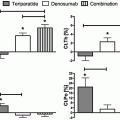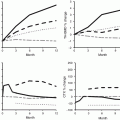Construct
Definition
Application
Perceived susceptibility
Individual assessment of vulnerability to the condition or disease
Individual believes that she/he has some likelihood of developing the index disease
Perceived severity
Individual’s belief that the condition/disease has serious consequences
Individual believes that this disease has unpleasant aspects—pain, dysmobility, and deformity—that can cause suffering
Perceived benefits
Belief that taking action will reduce the negative disease impact
Individual believes that behavior change will improve or prevent negative consequences such as pain and suffering
Perceived barriers
Belief that taking action has tangible and/or psychological costs
Individual sees how barriers can be overcome through reassurance and assistance
The HBM, as a guiding theory in research about chronic illnesses, focuses on two issues: patient attitudes and beliefs about the disease and patient benefits and barriers to carrying out appropriate treatment. When asked about perceived susceptibility and perceived severity in this model, patients respond with their perceptions of the susceptibility and severity of the disease itself [23]. This model is relevant for people undergoing dialysis [24], diabetes [25], and cancer [26]. As noted in Table 17.1, this means asking questions such as, “How vulnerable am I to this disease? Will I contract it? What are the odds? If I do, how serious will it be? Are there ways to manage it?”
HBM and Osteoporosis: Susceptibility and Severity
Osteoporosis, like many other asymptomatic chronic illnesses, has unique challenges and barriers. Researchers have used the HBM to examine different health-related behaviors for both prevention and treatment [27]. Remember that the focus of the model here is specifically to examine issues around compliance and persistence with prescription medications. Certainly other osteoporosis-related behaviors such as calcium and vitamin D, exercise, and avoidance of harmful lifestyle behaviors might also be framed in this model.
Table 17.2 includes the HBM framework but includes osteoporosis-specific issues. Column 4 contains specific osteoporosis applications of the first four constructs from the perspective of a Caucasian postmenopausal woman on corticosteroids with a family history of osteoporosis which is at high risk of this disease. Column 5 lists specific challenges to medication compliance and persistence that research has shown to be important potential causes of noncompliance. Again, the focus is on the original constructs of perceived susceptibility, perceived severity, perceived benefits, and perceived barriers.
Table 17.2
HBM and osteoporosis
Construct | Definition | Application | OP application | OP example |
|---|---|---|---|---|
Perceived susceptibility | Individual assessment of vulnerability to the condition or disease | Individual believes that she/he has some likelihood of developing the index disease | Postmenopausal white women and glucocorticoid users are at higher risk; mother had a hip fracture | According to Hsieh et al. [28], most women do not perceive a personal risk of OP. Believe it is a part of normal aging, not a disease |
Perceived severity | Individual’s belief that the condition/disease has serious consequences | Individual believes that this disease has unpleasant aspects—pain, dysmobility, and deformity—that can cause suffering | People die of hip fractures; women develop dowager’s hump from spinal fractures; nursing homes are filled with women with OP | According to McHorney et al. [29], side effects, cost, and uncertainty about necessity of treatment were important in noncompliance |
Perceived benefits | Belief that taking action will reduce the negative disease impact | Individual believes that behavior change will improve or prevent negative consequences such as pain and suffering | Taking CA, vitamin D, doing exercise, and taking medications reduce the risk of experiencing a fracture | Unclear what benefits exist because the side effect profiles have been so dominant in the news |
Perceived barriers | Belief that taking action has tangible and/or psychological costs | Individual sees how barriers can be overcome through reassurance and assistance | I don’t like taking medicine; OP medicine causes terrible side effects; I hate needles; I need my coffee first thing in the morning | Dosing regimen too difficult; dosing intervals too frequent or too difficult to remember |
Many studies of the HBM focus on the disease as the driving issue: What is perceived susceptibility to the disease? What is the perceived severity of the disease? What are the benefits of taking medication (or engaging in other positive health behaviors) to treat the disease? What are the perceived barriers to completing those important health behaviors? But I believe that, in the area of osteoporosis and its medications, patients have a different perspective. They wonder about certain aspects of osteoporosis (e.g., is it really a disease? is it unavoidable?) but do not concentrate on the answers to these items. Instead, they ask, “How susceptible am I to side effects of medications for osteoporosis? What are the consequences of taking the medications?” In terms of severity, patients ask, not about the disease but about the severity of medication side effects: “What harm can this medication do? How serious is this?” They are caught up in the popular press myths about medication side effects and forget about the osteoporosis itself and the significant negative consequences such as pain, deformity, and reduced quality of life [30].
Perceived Susceptibility:
Osteoporosis: Is it a disease? Since the first pharmaceutical agent designed specifically to treat osteoporosis appeared in the marketplace (alendronate, 1995), consumers and some general healthcare providers have questioned the validity of the diagnosis of osteoporosis. The question is not whether it exists; people with multiple vertebral fractures or a hip fracture are evidence of bone thinning and fracture. The question is more whether osteoporosis is a disease (i.e., medical diagnosis) or simply a natural consequence of aging. Many women believe that because their mothers and grandmothers had dowager’s humps or broken hips and seemed unable to avoid its progression. So believing that osteoporosis is truly a pathological condition and neither a figment of big pharmaceutical companies’ imaginations nor a normal consequence of aging is essential. If this is not a disease process, then why bother with diagnostic testing and pharmaceutical treatments? Only a disease to which someone is vulnerable should be treated with medications.
If women search the Internet to determine whether osteoporosis is truly a disease, they will find oppositional opinions. On sites sponsored by the National Osteoporosis Foundation (NOF), the American Society of Bone and Mineral Research (ASBMR), the National Institutes of Health (NIH), or other science-based organization, they will find strong support for the disease perspective on osteoporosis and the need for prescription medications to prevent future disease deterioration or fracture. However, they need only ask, “Is osteoporosis REALLY a disease?” to be given links to sites such as Save Our Bones (http://saveourbones.com/osteoporosis-is-not-a-disease/) or a natural way to health site with bone information (https://w3.newsmax.com/newsletters/brownstein/osteo.cfm) which tells readers that Big Pharma is lying to them in order to make a profit.
In short, many women read these websites and other sources of the “osteoporosis is not a disease” paradigm and believe that their primary susceptibility is to believing the medicalization of osteoporosis. In other words, they view osteoporosis medicines, not osteoporosis, as the threat.
Osteoporosis: My mother and grandmother had it. That means I’ll get it… right?
Perceived Severity:
Do potential side effects cause people to become noncompliant with all osteoporosis medications? Women hear the message that osteoporosis medications are dangerous in and of themselves. Early postmarketing use of bisphosphonates revealed a substantial number of GI problems (especially in the esophagus) that hadn’t been seen in the randomized Phase III trials. However, the trials had excluded people with GI disease, so the investigators had no way of knowing how or whether this medication could have such consequences. Patients and providers became concerned about these outcomes but initially had few options because other medications were not available. Recent studies suggest that oral bisphosphonates increase the risk of upper- and lower-GI side effects [31]. However, it is credible that these reports have consistently contributed to the reduction in compliance and persistence with alendronate treatment.
As time went on and more bisphosphonates were brought to market, additional side effects were identified. The three most significant side effects received media coverage and became so frightening that many women elected not to take antifracture medication at all rather than take a chance that they would experience of these. The first, osteonecrosis of the jaw (ONJ) , appeared in the scientific literature as potentially caused by bisphosphonates in 2003 when Ruggiero and colleagues [32] published the first peer-reviewed article in which they described 63 case studies of patients who had received bisphosphonates and also presented with ONJ. This article has subsequently been cited by over 1500 additional articles on the same topic. Because this caused a maelstrom of concern by patients and dentists alike, the ASMBR established a Task Force on ONJ and ultimately published a report from it in 2007 [33]. This Task Force noted that the risk of ONJ was estimated to be between 1 in 10,000 and <1 in 100,000 patient-treatment years. They also stated that patients with cancer who received high-dose IV bisphosphonate therapy had a substantially higher risk (1–10 per 100 patients) depending on the duration of the therapy. Subsequent research supported these findings, but the media ran headlines such as, “Drug for Bones Is Newly Linked to Jaw Disease” (New York Times, 6/2/2006) or “Study Links Osteoporosis Drugs to Jaw Trouble” (Washington Post, 1/1/2009). Not surprisingly, people on or contemplating taking these drugs expressed concern about their impact, and many never started them or quit immediately.
A second major and potentially frightening side effect of bisphosphonates that has contributed substantially to the reduced number of bisphosphonate users is the atypical femur fracture. Atypical subtrochanteric fractures were identified in women who had been on long-term bisphosphonates [34]. The first reports came out in the early 2000s, and ASBMR had established a Task Force on this topic as well, and its report was published in 2010 [35]. In it, the authors noted that these fractures occurred in some people who had been on long-term bisphosphonate therapy (mean duration = 7 years) and appeared more frequently in those people with glucocorticoid-induced osteoporosis than in postmenopausal osteoporosis. Again, like ONJ, these fractures are extremely rare (2 per 100,000 cases per year for 2 years of BP use to 78 per 100,000 cases per year for 8 years of BP use) [36].
Other potential side effects including atrial fibrillation and osteosarcoma add to the growing list of potential negative consequences of taking bone strengthening medications as portrayed by the media (see New York Times, Wall Street Journal). The media have jumped on the bandwagon, telling women that these medications are not safe and implying that the side effects are more prevalent than they really are. In addition, websites such as https://www.lawyersandsettlements.com/lawsuit/bisphosphonates-side-effects-lawsuits.html and http://www.youhaveala-wyer.com/bisphosphonates/ offer legal services to patients who want to sue the makers of these drugs in class action litigation.
Perhaps, it is no wonder that many osteoporosis patients stop taking their medications as directed (or never start them). Barraged on all sides by conflicting but threatening information about the consequences of these drugs, they hear terms such as “cancer” and “jaw death” and decide not even to listen to the information provided by legitimate prescribers. Although the American Dental Association convened an expert panel which agreed that ONJ was very rare and recommended that dentists not modify routine dental work based only on the fact that a patient was taking a bisphosphonate [37], anecdotal evidence suggests that many community dentists are recommending that patients stop bisphosphonate therapy altogether; some will not treat patients on oral or IV bisphosphonates. Unfortunately, the expert panel advice has not disseminated through the dental community or to dental patients; instead, the communications of some practicing dentists have added confusion and incorrect information to the question of bisphosphonate treatment for osteoporosis.
Thus, it appears to be the severity of side effects of the medications rather than osteoporosis itself which influences women in choosing to become noncompliance and nonpersistent. That osteoporosis patients and those at risk of this disease fear the consequences of treatment more than they fear the disease itself is remarkable.
Perceived Benefits:
Positive outcomes of taking osteoporosis medications. Health behaviors are directed by many factors. An obvious example that promotes compliance and persistence with medications are benefits from taking medications. In some areas, this is easy to see. If you have a headache, take a pain medication, and the headache disappears. That is a benefit. If you suffer from diabetes, then insulin prevents your blood sugar from getting too far out of balance to avoid diabetic coma or insulin shock. Because these negative outcomes are obvious to patients, their benefits are easily identified. This is true for many symptomatic problems from colds to constipation.
Unfortunately, the positive changes in bone that result from compliance and persistence with osteoporosis medications are more subtle and cannot be immediately perceived by patients after they take medication. The scientific literature is replete with empirical and review articles that discuss the ways in which antifracture medication works and benefits the patients.
Perceived Barriers:
Complexity of dosing regimens. According to the HBM, patients who are noncompliance with their medication regimens often make this choice based on insurmountable barriers they see to the successful medication behaviors. In particular, the unusual dosing regimen of oral bisphosphonates inspires many patients to reject these medications before even trying them or shortly after beginning them. The rigid ritual of taking these medications first thing in the morning on an empty stomach with 6–8 ounces of plain water is seen as distasteful. Add to that the delay in eating or drinking anything else for 30–60 min and needing to remain upright (not reclining) for 30 min as the final reason for rejecting these medications. Other medications, including teriparatide, monthly ibandronate, denosumab, and zoledronic acid, require the use of an injection/infusion—sometimes as frequently as daily. Depending on their personal fears and beliefs, those with osteoporosis feel burdened by this regimen and believe that they cannot successfully sustain these rituals over time. Thus, perceived serious side effects and difficult dosing regimens encourage many patients not to take their osteoporosis medication.
Dosing Interval and Drug Delivery Systems
Knowing that the bioavailability of oral bisphosphonates is poor even under the best circumstances and how important it is for patients to take these medicines correctly, pharmaceutical researchers began searching out ways to maximize the likelihood of compliance and persistence. They hypothesized that patients, disliking the dosing regimens of these drugs, would be more likely to follow them if easier dosing options were offered [38].
Given that they could not change the strict regimen for taking oral bisphosphonates, pharmaceutical researchers concentrated on dosing duration as a means by which to enhance patient compliance and persistence. The first two oral bisphosphonates (alendronate and risedronate) went from daily to weekly dosing. Marketers believed that having to delay coffee or breakfast once a week rather than every morning would be viewed as a major improvement. In Table 17.3, osteoporosis medications approved in 1995 or later are listed with frequency of dosing and dosing method, and additional relevant information is provided.
Table 17.3
FDA-approved osteoporosis medications by dose duration and delivery method
Medication | Dose frequency | Delivery method | Approval date |
|---|---|---|---|
Alendronate | Dailya | Oral | 1995 |
Weeklya | Oral | 2000b | |
Risedronate | Dailya | Oral | 2000 |
Weeklya | Oral | 2002c, d | |
Monthlya | Oral | 2012 | |
Ibandronate | Monthlya | Oral | 2005e, f |
Every 3 months | IV injection | 2006 | |
Zoledronic acid | Annually | IV infusion | 2007 |
Raloxifene | Daily | Oral | 1997g |
Teriparatide | Daily | Subcutaneous self-injection | 2002 |
Denosumab | Every 6 months | IV injection | 2010 |
Studies began almost immediately to determine whether the different dosing durations also differed in their compliance and persistence rates. With alendronate and risedronate, weekly dosing showed significant improvement in compliance and persistence over daily dosing [39, 40]. Initially, it appeared that patients preferred a monthly bisphosphonate to weekly dosing [41]. However, when patients were told about efficacy differences in the monthly (ibandronate) as opposed to weekly (alendronate, risedronate), this was no longer the case [42, 43]. Other studies reported that database studies showed better adherence with monthly over weekly dosing intervals [44], but little additional empirical evidence was found.
Although, it was convenient to believe that infrequent dosing would improve compliance and persistence with antifracture medication, Lee and colleagues [45] reviewed published articles between 1970 and 2009 to see if this variable (i.e., time to next dose) was truly making a difference in medication behaviors. In an outstanding article, these researchers agreed that there was a clear trend that weekly medications had better compliance and persistence than daily medications but that the longer intervals did not make a significant difference in compliance. They suggest that efficacy, side effects, and administration route are far more important to compliance and persistence than is dosing interval. And some studies show that even the annual dosing of zoledronic acid is no guarantee of persistence with this medicine over time [46]. And the consequences of a single missed dose with a yearly interval are substantially more concerning than those of a daily, weekly, or even monthly medication.
Stay updated, free articles. Join our Telegram channel

Full access? Get Clinical Tree







